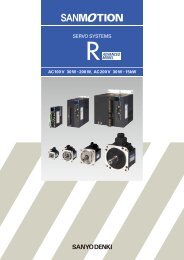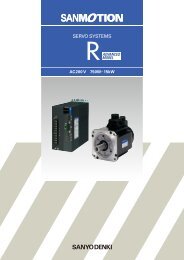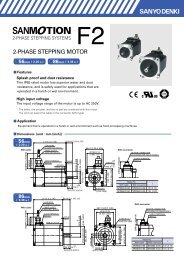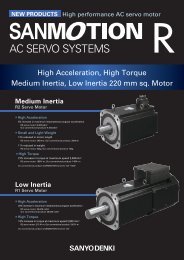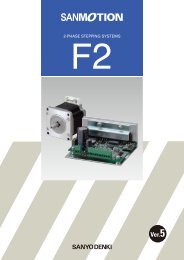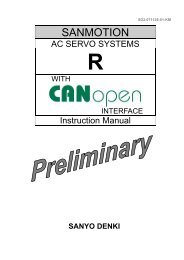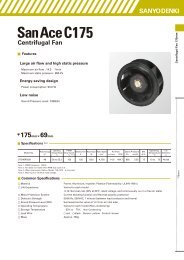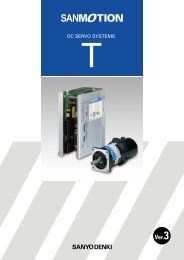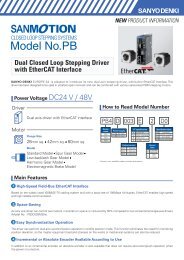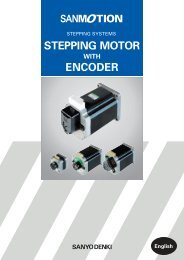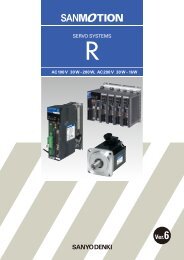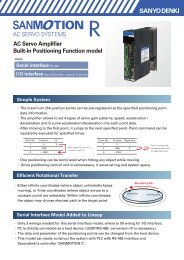5-PHASE STEPPING SYSTEMS - sanyo denki europe
5-PHASE STEPPING SYSTEMS - sanyo denki europe
5-PHASE STEPPING SYSTEMS - sanyo denki europe
Create successful ePaper yourself
Turn your PDF publications into a flip-book with our unique Google optimized e-Paper software.
DC input Set modelMicro step<br />
Connections and Signals<br />
External wiring diagram<br />
Phase origin monitor output MON<br />
Auto-Current-Down canceling input ACDOFF<br />
Step angle selection input SSEL<br />
CN2<br />
1<br />
2<br />
3<br />
4<br />
5<br />
6<br />
Driver<br />
CN3<br />
1<br />
2<br />
3 Motor<br />
4<br />
5<br />
Blue<br />
Red<br />
Orange<br />
Green<br />
Black<br />
CW pulse input CW<br />
CCW pulse input CCW<br />
Power down input PD<br />
7<br />
8<br />
9<br />
10<br />
11<br />
12<br />
CN4<br />
1<br />
2<br />
Regeneration<br />
resistor<br />
Model NoFFE-01<br />
Connect the regenerative resistor<br />
when there is a risk that the supply<br />
voltage could exceed 60 V DC due<br />
to the motor's back emf.<br />
CN1<br />
DC24V/48V<br />
1<br />
DC24G/48G<br />
2<br />
Applicable wire sizes<br />
Part Applicable wire Insulation diameter Wiring length<br />
Power supply AWG20 (0.5mm 2 ) to AWG18 (0.75mm 2 ) 1.7 to 3.0mm Less than 3m<br />
Input/output<br />
signal<br />
AWG24 (0.2mm 2 ) to AWG22 (0.3mm 2 ) 1.15 to 1.8mm Less than 3m<br />
Motor AWG20 (0.5mm 2 ) to AWG18 (0.75mm 2 ) 1.7 to 3.0mm 10m max.<br />
When bundling wire together or running wires through duct, take reduction rate of each wire allowable current into consideration. When ambient temperature is relatively<br />
high, wire product lifetime is reduced due to heat deterioration. In this case, please use Heat resistant Indoor PVC (HIV).<br />
Specification summary of CN2 I/O signal<br />
Signal name<br />
Phase origin<br />
monitor output<br />
(standard)<br />
Alarm output<br />
Auto-Current-<br />
Down canceling<br />
input<br />
Step angle<br />
selection input<br />
CW pulse input<br />
(standard)<br />
Pulse column<br />
input<br />
CCW pulse input<br />
(standard)<br />
Rotation<br />
direction<br />
input<br />
Power down<br />
input<br />
CN2 Pin<br />
number<br />
1<br />
2<br />
1<br />
2<br />
3<br />
4<br />
5<br />
6<br />
7<br />
8<br />
7<br />
8<br />
9<br />
10<br />
9<br />
10<br />
11<br />
12<br />
Function<br />
DSW1 MODE1=OFF<br />
Photocoupler is turned on when excitation phase is the origin (the state power supply is turned on).<br />
DSW1 MODE1=ON<br />
Photocoupler is turned on when the driver is in the state of alarm being activated.<br />
Inputting this signal (internal photpcoupler is turned on) disables Auto-Current-Down function.<br />
Division numbers can be switched via SSEL-signal.<br />
Internal photocoupler is OFF Setting via rotary switch SS1 enabled<br />
Internal photocoupler is ON Setting via rotary switch SS2 enabled<br />
When using2-input mode<br />
Drive pulse for the CW direction rotation is input.<br />
When usingPulse and direction mode<br />
Drive pulse train for the stepping motor rotation is input.<br />
When using2-input mode<br />
Drive pulse for the CCW direction rotation is input.<br />
The rotation direction signal of stepping motor is input for the Pulse and direction mode.<br />
Internal photocoupler ON CW direction<br />
Internal photocoupler OFF CCW direction<br />
Inputting this signal (internal photocoupler is turned on) shuts off the current carried to motor.<br />
The CW rotation direction of stepping motor means the clockwise direction rotation as viewed from the output shaft side (ange side).<br />
The CCW rotation direction means the counterclockwise direction rotation as viewed from the output shaft side (ange side).<br />
56




